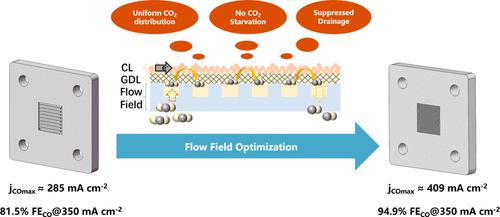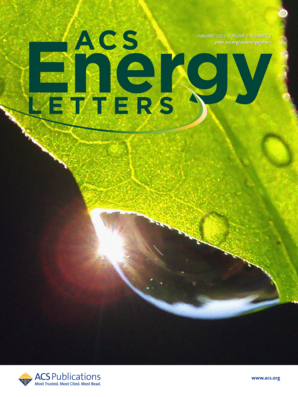高电流密度零间隙二氧化碳电解槽的流场设计至关重要
IF 19.3
1区 材料科学
Q1 CHEMISTRY, PHYSICAL
引用次数: 0
摘要
二氧化碳电解槽的商业化需要更高的电流密度。这项工作证明了流场优化对开发高电流密度二氧化碳电解槽的必要性。我们以三种典型流场(蛇形流场、平行流场和交错流场)为工具,结合多种表征技术,研究了进一步优化流场的原则。我们认识到,优化流场不仅包括提高二氧化碳分布的均匀性和确保无二氧化碳饥饿。它还需要在确保抑制排水行为的同时提供二氧化碳的流过运输。根据这一原则进行优化后,我们制作了一个多蛇形流场,在 0.1 M KHCO3 和 50 °C 池温条件下,0-350 mA cm-2 的 CO 选择性高达 95%。同时,它还实现了 409 mA cm-2 的 CO 部分最大电流密度,比传统的平行流场高出 43.5%。本文章由计算机程序翻译,如有差异,请以英文原文为准。

Flow Field Design Matters for High Current Density Zero-Gap CO2 Electrolyzers
The commercialization of CO2 electrolyzers requires higher current densities. This work demonstrates the necessity of flow field optimization for developing high-current-density CO2 electrolyzers. Using three typical flow fields (serpentine, parallel, and interdigitated) as tools and combining multiple characterization techniques, we investigated the principles for further flow field optimization. We recognized that optimizing the flow field involves more than enhancing CO2 distribution uniformity and ensuring no CO2 starvation. It is also necessary to provide CO2 flow-through transport while ensuring suppressed drainage behavior. Optimizing based on this principle, we fabricated a multiserpentine flow field, and it realized a high CO selectivity of about 95% at 0–350 mA cm–2 with 0.1 M KHCO3 and 50 °C cell temperature. Meanwhile, it achieves a high maximum CO partial current density of 409 mA cm–2, which is 43.5% higher than that of the conventional parallel flow field.
求助全文
通过发布文献求助,成功后即可免费获取论文全文。
去求助
来源期刊

ACS Energy Letters
Energy-Renewable Energy, Sustainability and the Environment
CiteScore
31.20
自引率
5.00%
发文量
469
审稿时长
1 months
期刊介绍:
ACS Energy Letters is a monthly journal that publishes papers reporting new scientific advances in energy research. The journal focuses on topics that are of interest to scientists working in the fundamental and applied sciences. Rapid publication is a central criterion for acceptance, and the journal is known for its quick publication times, with an average of 4-6 weeks from submission to web publication in As Soon As Publishable format.
ACS Energy Letters is ranked as the number one journal in the Web of Science Electrochemistry category. It also ranks within the top 10 journals for Physical Chemistry, Energy & Fuels, and Nanoscience & Nanotechnology.
The journal offers several types of articles, including Letters, Energy Express, Perspectives, Reviews, Editorials, Viewpoints and Energy Focus. Additionally, authors have the option to submit videos that summarize or support the information presented in a Perspective or Review article, which can be highlighted on the journal's website. ACS Energy Letters is abstracted and indexed in Chemical Abstracts Service/SciFinder, EBSCO-summon, PubMed, Web of Science, Scopus and Portico.
 求助内容:
求助内容: 应助结果提醒方式:
应助结果提醒方式:


